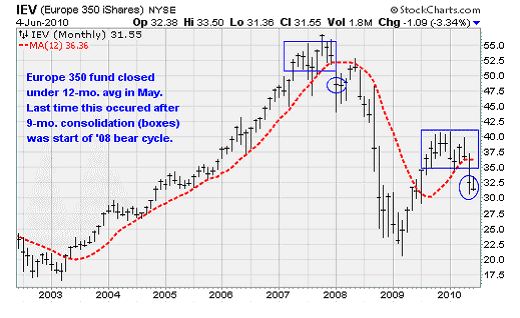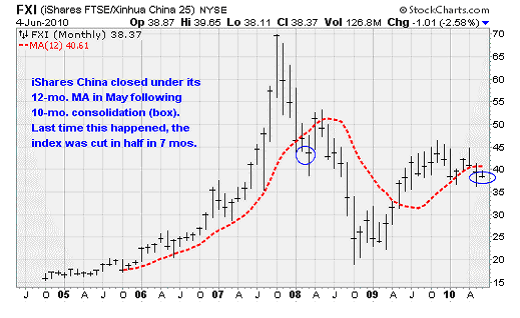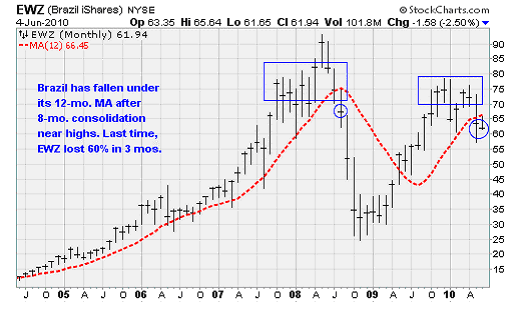Why U.S. Stocks Can Outshine Faltering Global Economic Growth
Stock-Markets / Stock Markets 2010 Jun 07, 2010 - 06:15 AM GMTBy: Money_Morning
 Jon D. Markman writes: After another lousy week, it's official: Global markets have suffered the worst late-spring setback since 1940 -- a May-June period when the Germans invaded the Netherlands, then marched into Paris, and Italy declared war on France and Great Britain. Just like that, seven decades ago, World War II was on, and markets went into freefall.
Jon D. Markman writes: After another lousy week, it's official: Global markets have suffered the worst late-spring setback since 1940 -- a May-June period when the Germans invaded the Netherlands, then marched into Paris, and Italy declared war on France and Great Britain. Just like that, seven decades ago, World War II was on, and markets went into freefall.
If stocks are as good at anticipating global calamity this time as they were in that horrible spring 70 years ago, we may be in for a terrible second half.
It's a bitter irony that so many of those old enmities are flaring up again on the Continent at this critical time. The European Union was created two decades ago at behest of the former Allies to prevent the Continent from sliding into armed conflict again, and the euro currency was later launched to cement the new political relationship.
But many centuries of deep-seated distrust are hard to negate with diplomacy and idealistic optimism, and now we see Europeans back at each others' throats in a flurry of recriminations over who is to blame for outrageous deficits, debts and defaults in the Eurozone -- and more importantly, who should pay for them.

I don't see how this is going to end well, as populism swells in each country and domestic politics ties leaders' hands. On an international level the European elite recognizes that they must work together or they will fail separately. But politicians' first instinct is to remain in office, and they will end up pandering to their voters.
We can see now that a mish-mash of responses to debt holders' demands is creating ever more confusion and anxiety. Credit bears are taking advantage by attacking the weaker countries' debts with brazenness not seen since 2008. Unless governments can lock arms against the bears' predations soon, we are looking at the potential for a long, hot summer punctuated by a rising chance of civic riots, corporate and sovereign defaults and economic slowdown.
Meanwhile here in the United States, our economy is recovering at a relatively tepid pace from the 2008-2009 recession. Corporate earnings growth at this time is awesome, as you'll see in a minute, and employment growth is not far behind, but both may come to be seen as fragile.
As former U.S. Defense Secretary Donald Rumsfeld archly said back in 2001, it's not the known problems that hurt you, or even the unknown problems. It's the “unknown unknowns”, the stuff that comes at you from the blue.
For the United States over the rest of this year, the most fearsome “unknown unknown” is the extent to which the BP PLC (NYSE ADR: BP) oil drilling disaster in the Gulf of Mexico could curb the recovery and send growth tumbling back toward the flat line. I'm hearing from my sources in the hedge fund world that the bill will ultimately run into the tens of billions of dollars -- far more than current estimate -- and could ultimately rival the credit crisis of 2007-2009 in impact. That would be particularly true if BP -- whose credibility is shot -- cannot stop the well from spewing crude oil into the ocean by late August.
Among the potential impacts are a moratorium on U.S. offshore drilling that could send oil and gas prices skyrocketing and drilling company profits stymied, a cessation of shipping traffic in the Gulf of Mexico that would prevent our grain exports from heading overseas from the mouth of the Mississippi River, a devastation of the south Atlantic and Gulf fisheries, and the ruin of summer beach tourism and seaside real estate values.

Meanwhile global stocks and bonds have reeled as the impact of new austerity budgets in Europe and the withering of credit in China are measured by market participants.
The broadest measure of U.S. stocks closed May above its critical 12-month average to remain just barely in bull mode. But measures of large-cap companies like the iShares S&P Europe 350 Index (NYSE: IEV), iShares FTSE/Xinhua China 25 Index (NSYE: FXI) and iShares MSCI Emerging Markets Index (NYSE: EEM) closed May below their 12-month averages, a distinction that in the past has delineated the start of a new bear market.

Markets in certain countries, like Chile (NYSE: ECH) and Indonesia (NYSE: IDX) remain relatively robust, but most other export-oriented countries that are dependent on U.S., European and Chinese economic growth, such as Brazil (NYSE: EWZ) are suffering. Moreover the U.S. corporate bond market, which has been stable and strong the past year and a half even when equities were shaky, has started to roll over, too.
Bottom Line: Shares of U.S. companies are still only around 10% from their highs, but the global growth environment in which they can thrive is faltering. These foreign markets were all super-strong in 2003-2007, never closing below their 12-month averages, and whenever the U.S. started to weaken they provided a source of comfort. Now the U.S. is essentially a single island of stability and strength, and even that is being threatened by an oil spill that could have a surprising impact on second-half growth, and the potential for a shutdown in European government purchases amid a drive to reduce deficits and avoid bond downgrades.
No single nation can divorce itself from the rest of the world anymore; those days are past. We're all in this together. It will be very hard if not impossible for U.S. companies to maintain their growth path if customers in Europe and China thin out. Multinational companies like Colgate Palmolive Co. (NYSE: CL) and IBM Corp. (NYSE: IBM) earn more than half of their income overseas. Optimistic growth estimates and price/earnings multiples must be questioned.
Still, a caveat to warn you against becoming too pessimistic. Last week, I showed you evidence that investor and media confidence is near extreme lows not witnessed since March 2009. These periods of high negativity tend to be good times to put money to work in stocks, at least for a few weeks -- and longer if they catch hold.
Putting all of this together, the fundamentals, sentiment and technicals suggest that modest exposure to U.S. stocks combined with a short exposure to Europe, China and Brazil are the way to go at this time. The die is cast overseas with the overseas markets' May closes under the 12-month averages, and my model recommends that investors would be best served, for a single position, with an inverse exchange-traded fund (ETF) focused on the European, Australasia and Far East region, which fund managers call the EAFE. If this cycle is anything like past cycles, the price discovery that has shown up as consolidation near highs over the past eight months overseas has given way on the downside, and that is now the direction of least resistance.
I am not going to recommend new positions today, as I am traveling and don't have access to all my data and charts. Look for them later in the week, most likely as soon as Tuesday. My favorite play on the long side is likely to be natural gas, and you know my leanings on the short side are in Europe and Asia. Please stay in synch with us now, as the second half of the year is going to be a little crazy.
Profit Picture
Now you know that I never like to leave you in total despair, because there are always positives to talk about. So let's spend a couple of minutes looking at the success companies have had of late. Profits are rising more than 30% on a year-over-year basis -- something that has only happened six other times in the last 60 years.
This should be great news for the rest of the economy: According to Barclays Capital, rising corporate profits tends to lead GDP and employment growth. Moreover, and this is absolutely critical: they believe the profit boom will have a bigger influence on the economy than the European debt crisis.

During the first three months of the year, profits jumped 31% -- the best quarterly gain since 1984 (which happens to coincide with the beginning of one of the greatest stock bull markets in history). And the impressive performance isn't just relegated to the financial sector moving over easy year-ago comparisons. The nonfinancial sector is seeing profit growth of 26%.
In each of the previous six periods of similar expansions in profitability, Barclays Capital notes that the economy grew at an inflation-adjusted pace of at least 3% in the following year and by job growth of 1.9% or better. With today's labor force, that would suggest the creation of 2.5 million jobs.
But what about Europe? The Barclays Capital team took a look at the avenues by which the euro crisis could be transmitted into the U.S. economy. The most obvious is a reduction in stock market wealth, which would crimp spending. But the decline so far has been modest in comparison to the gains enjoyed since the March 2009 low. The Standard & Poor's 500 gained 83% from its low to its April high and has subsequently lost 10.6%. There is also little sign of a negative influence on consumer sentiment or of panic returning to the credit markets.
In fact, the biggest influence from the European troubles could actually be positive since it has pushed crude oil prices down 15% over the past month as frantic traders pushed up the value of the dollar. This should help pull inflation down further at a time when wage and salary income is set to accelerate sharply in the current quarter as job growth and hours worked increase. The BarCap team expects this combination to increase disposable income by more than 4%. In their words, this would "provide the foundation for another strong quarter for real consumer spending."
Combine increased business spending driven by record profitability , add real income growth and a benign inflation outlook, and top it with ultra-low interest rates, and you have all the reason that bulls remain optimistic about growth trajectory of the economy.
Now if only those other negative forces would remain at bay.
Week in Review
Monday: ISM Manufacturing Index printed at 59.7, which was slightly above consensus expectations. It showed strong month-over-month growth for new orders in manufacturing. Subindexes showed continuing strength in production, backlogs and export orders. Input prices weakened. The advance suggested a large draw on inventories, which means there will be a need for inventory restocking and further boosts to production - positive report that supported positive view of U.S. manufacturing.
Construction spending showed a robust 2.7% gain in April over the prior month as the special tax credits for new homebuyers expired. Consensus expected no change. The boost was mostly led to a jump in spending on private residential construction, which was up 4.4%. Private non-residential construction was up 1.7%.
Tuesday: Motor vehicle sales were reported very solid in May, clocking in at an annual adjusted rate of 11.6 million, bettering the 11.2 million in April. Strength was most notable in domestic made trucks, as other categories showed no significant change.
The Mortgage Bankers Association's purchase index continued to plunge, falling 4.1% in the last week of May to post a new 13-year low. The index is down more than 40% from four weeks ago as April's end to stimulus has apparently dried up the home sales market. The refinance index, up 2.4%, has been up for four weeks in a row as homeowners lock in low rates. The 30-year rate edged up 3 basis points to 4.83%.
Wednesday: Chain store sales came in soft in May mostly due to very cold weather across the country during a time when consumers were focused on buying clothes for summer. Year-on-year same-store sales trends moved down from the 5% - 8% range to the 3% - 5% range. Results pointed to mild weakness for the sales outside of gasoline and cars.
Factory orders showed positive momentum in April, rising 1.2%, though the figure was below consensus of 1.7%.
Friday: May payrolls were disappointing, with very slow growth in the private sector. The total number was +431,000 due to an increase in 411,000 jobs for U.S. Census workers. The number was well below the 544,000 consensus. Main positives were manufacturing, +29,000, temporary help services (up 31,000), and mining (up 10,000). On the downside were construction, -35,000, and financial activities, -12,000. The only positive news: Wage inflation picked up with a 0.3% rise in May, following a 0.1% advance the month before. The average workweek for all workers edged up to 34.2 hours from 34.1 hours in April. Production hours overall advanced 0.3% in May after a 0.4% rise the month before. Gains in temps and workweek point to future hiring. The aggregate hours jump for manufacturing suggests a robust increase in industrial production for the month.
The Week Ahead
Monday: Consumer credit for April will be announced at noon. Reporting earnings: Altera Corp. (Nasdaq: ALTR).
Tuesday: Redbook measure of sales at chain stores, discounters and department stores, giving the pulse of two-thirds of the U.S. economy. Reporting earnings: Bob Evans Farms, Inc (Nasdaq: BOBE), Mobile Telesystems OJSC (NYSE ADR: MBT), Pall Corp. (NYSE: PLL), The Pep Boys (NYSE: PBY), Texas Instruments Inc. (NYSE: TXN).
Wednesday: Mortgage Bankers' Association will report various mortgage loan indexes' gains and losses, a leading indicator of single-family home sales and housing construction. Reporting earnings: Ciena Corp. (Nasdaq: CIEN), Korn/Ferry International (NYSE: KFY), Luby's, Inc. (NYSE: LUB), The Mens Wearhouse, Inc. (NYSE: MW), Titan Machinery, Inc. (Nasdaq: TITN).
Beige Book, which is produced two weeks before Federal Reserve monetary policy meetings, provides anecdotal evidence of economic conditions from the 12 Fed districts.
Fed chief Ben Bernanke will speek at the Richhmond Federal Reserve Bank forum on employment trends.
Thursday: Jobless claims for the past week will be reported. The last one showed only modest improvement from, the prior week. Earnings: Del Monte Foods Co. (NYSE: DLM), National Semiconductor Corp. (NSYE: NSM).
Friday: University of Michigan Consumer Survey results for May will be released. Strong consumer sentiment and confidence are required for robust spending to continue. Reporting earnings: Volt Information Sciences, Inc. (NYSE: VOL).
[Editor's Note: Money Morning Contributing Writer Jon D. Markman has a unique view of both the world economy and the global financial markets. With uncertainty the watchword and volatility the norm in today's markets, low-risk/high-profit investments will be tougher than ever to find.
It will take a seasoned guide to uncover those opportunities.
Markman is that guide.
In the face of what's been the toughest market for investors since the Great Depression, it's time to sweep away the uncertainty and eradicate the worry. That's why investors subscribe to Markman's Strategic Advantage newsletter every week: He can see opportunity when other investors are blinded by worry.
Subscribe to Strategic Advantage and hire Markman to be your guide. For more information, please click here.]
Source: http://moneymorning.com/2010/06/07/global-markets-4/
Money Morning/The Money Map Report
©2010 Monument Street Publishing. All Rights Reserved. Protected by copyright laws of the United States and international treaties. Any reproduction, copying, or redistribution (electronic or otherwise, including on the world wide web), of content from this website, in whole or in part, is strictly prohibited without the express written permission of Monument Street Publishing. 105 West Monument Street, Baltimore MD 21201, Email: customerservice@moneymorning.com
Disclaimer: Nothing published by Money Morning should be considered personalized investment advice. Although our employees may answer your general customer service questions, they are not licensed under securities laws to address your particular investment situation. No communication by our employees to you should be deemed as personalized investent advice. We expressly forbid our writers from having a financial interest in any security recommended to our readers. All of our employees and agents must wait 24 hours after on-line publication, or 72 hours after the mailing of printed-only publication prior to following an initial recommendation. Any investments recommended by Money Morning should be made only after consulting with your investment advisor and only after reviewing the prospectus or financial statements of the company.
Money Morning Archive |
© 2005-2022 http://www.MarketOracle.co.uk - The Market Oracle is a FREE Daily Financial Markets Analysis & Forecasting online publication.



